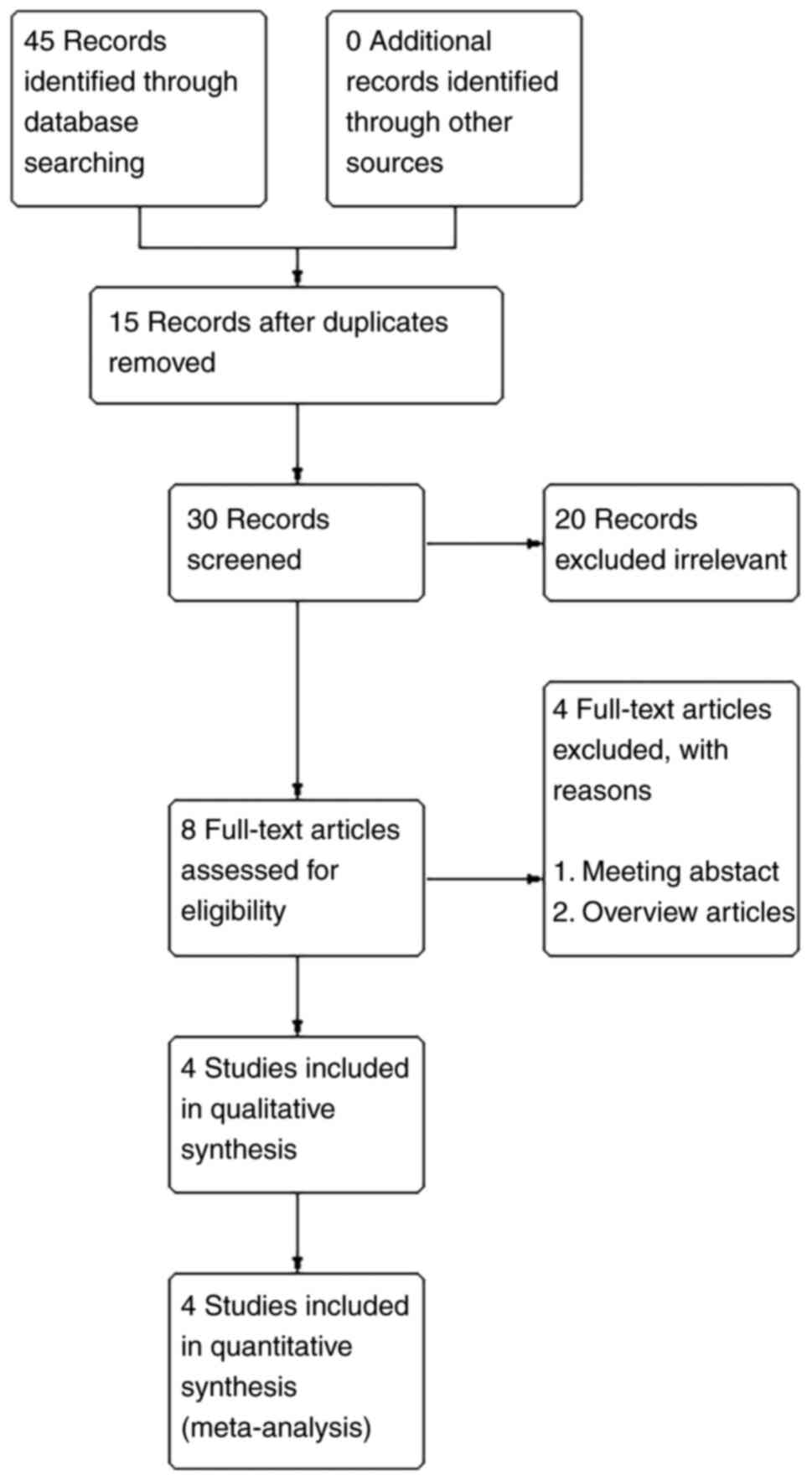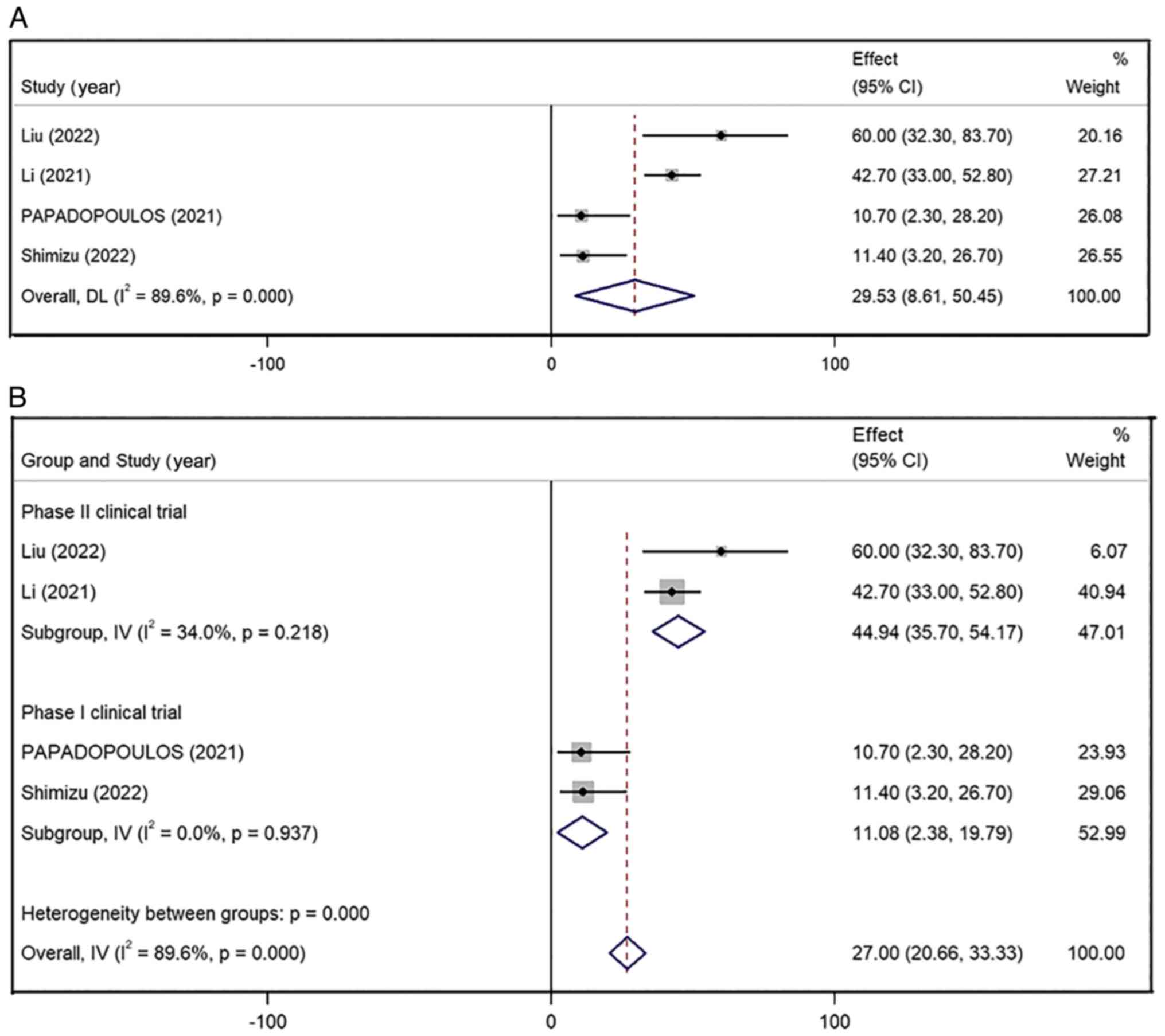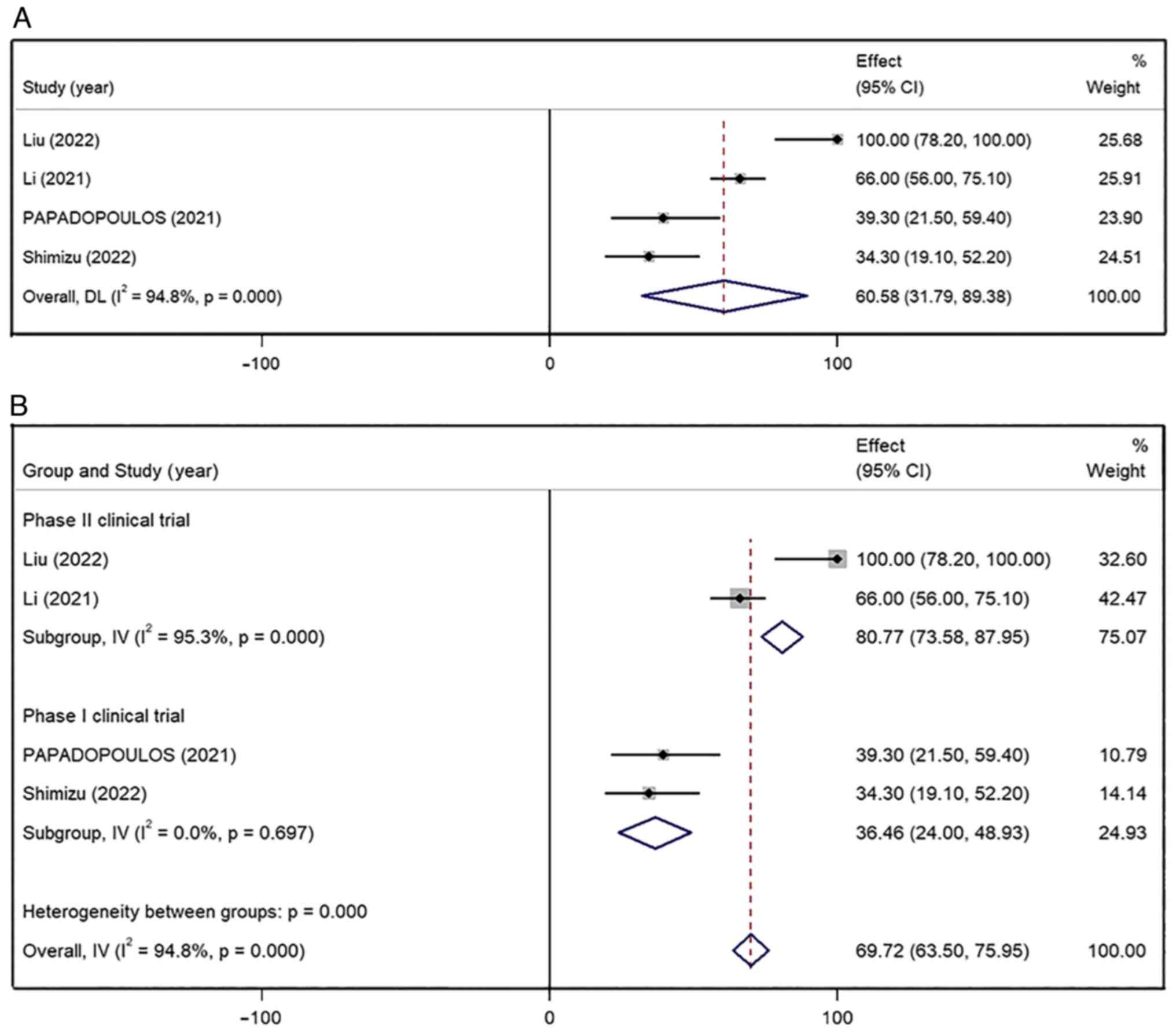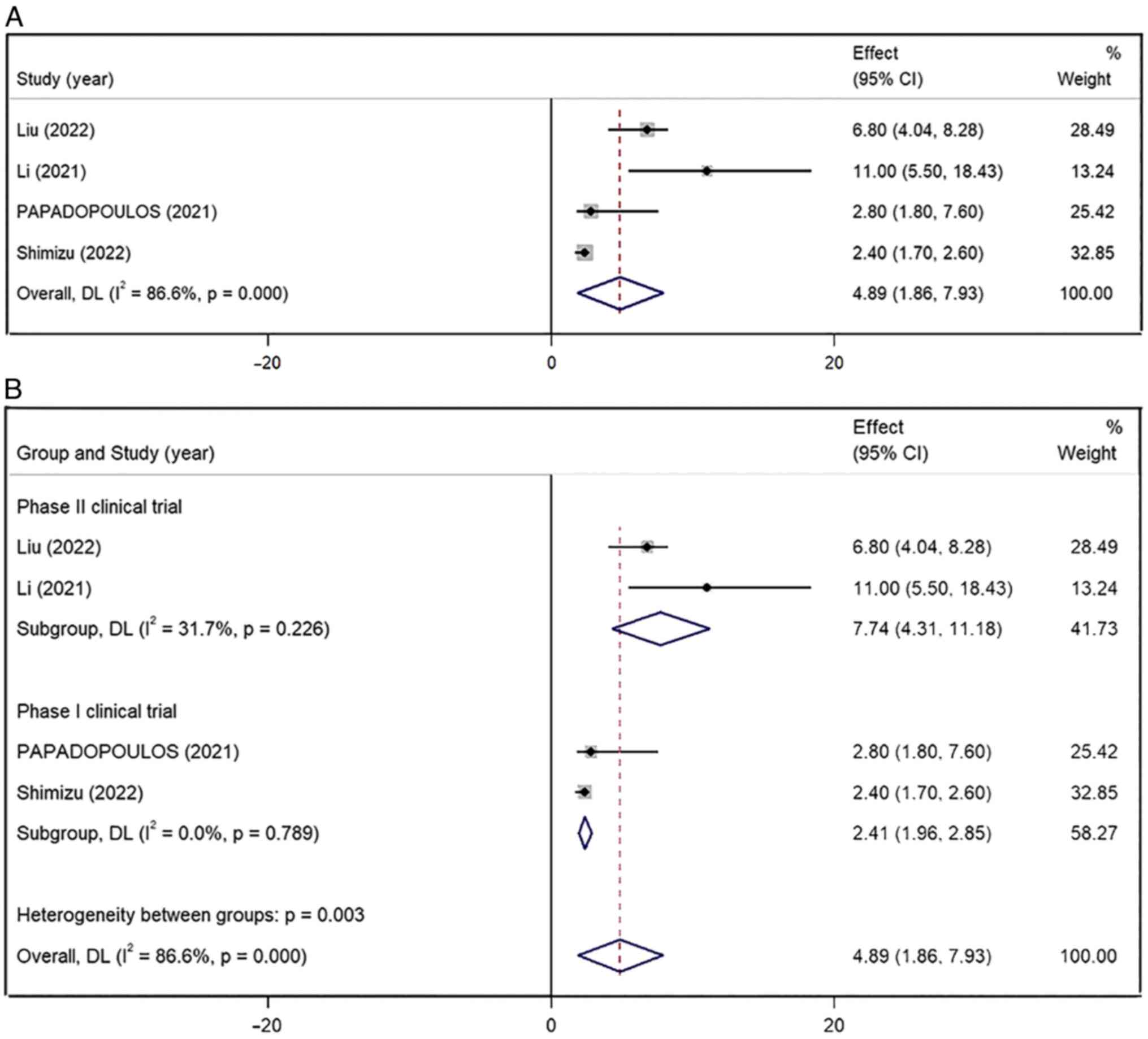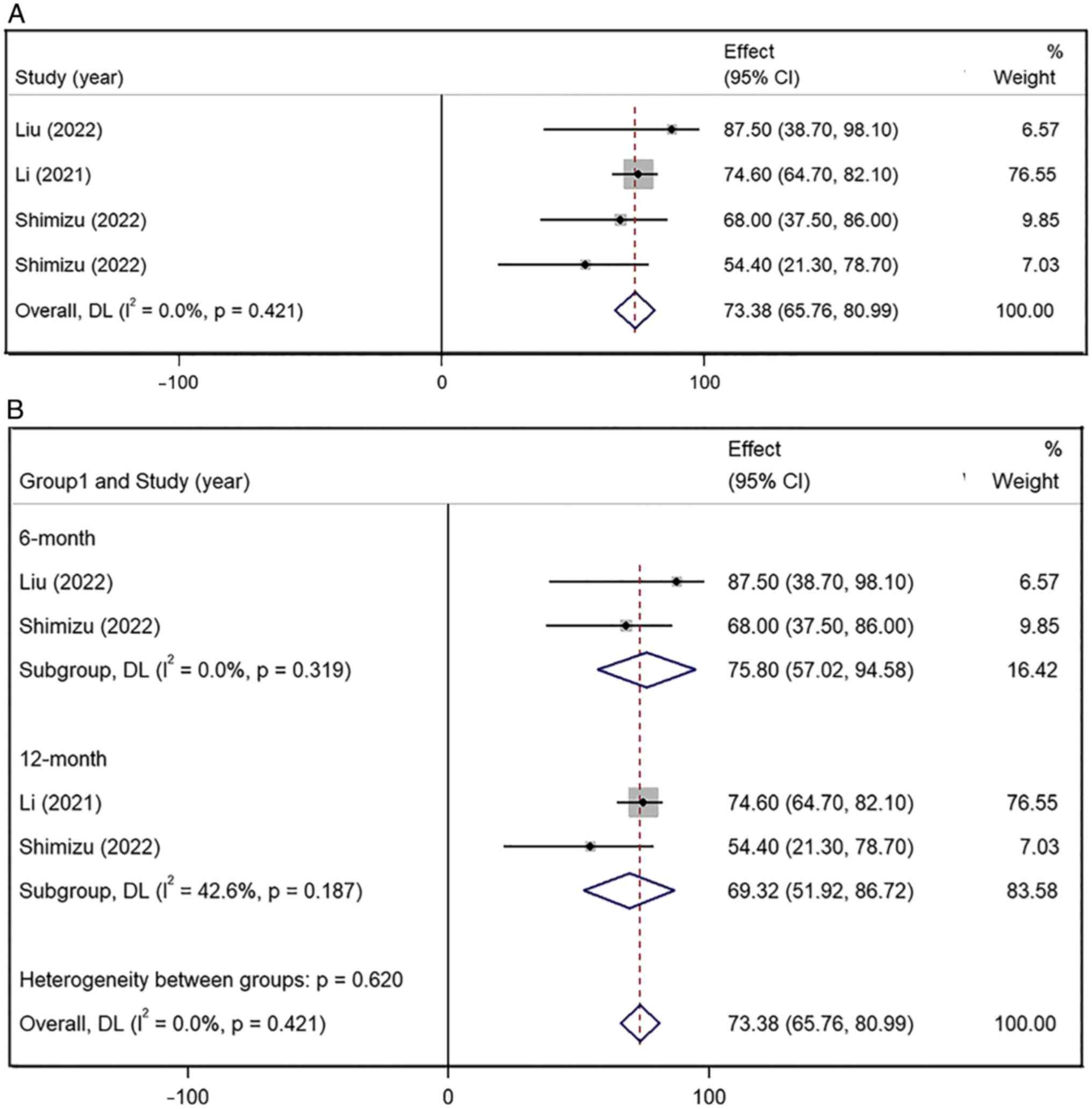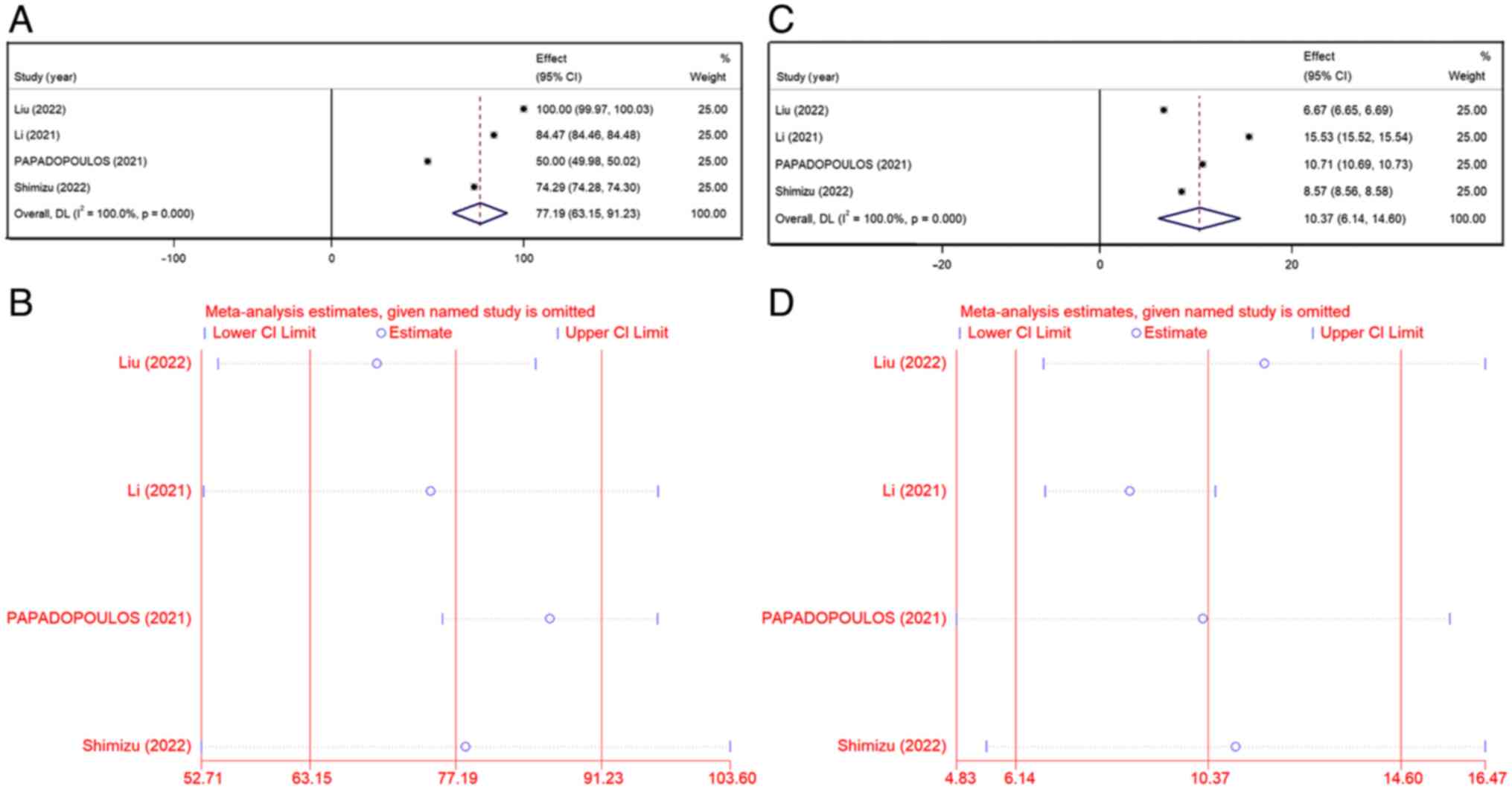Efficacy and safety of envafolimab in the treatment of advanced dMMR/MSI‑H solid tumors: A single‑arm meta‑analysis
- Authors:
- Published online on: June 30, 2023 https://doi.org/10.3892/ol.2023.13937
- Article Number: 351
-
Copyright: © Fan et al. This is an open access article distributed under the terms of Creative Commons Attribution License.
Abstract
Introduction
Immune checkpoint inhibitors of programmed cell death receptor-1 (PD-1) and programmed cell death ligand-1 (PD-L1) showed promising efficacy in a variety of malignancies (1). In recent years, the blockade of the PD-1/PD-L1 pathway with monoclonal antibodies emerged as a successful target for cancer immunotherapy. At present, several PD-1/PD-L1 inhibitors are approved worldwide for the treatment of multiple tumors, leading to a paradigm shift in the treatment of immuno-oncology therapies that provide durable remissions for patients with cancer (1). In particular, PD-1/PD-L1 inhibitors are also used for the treatment of tumors with high microsatellite instability (MSI-H). This type of tumor is characterized by deficient mismatch repair (dMMR), which results in microsatellite instability. In the study performed by Le et al (2), the mismatch repair state predicted a clinical benefit of immune checkpoint blockade therapy with pembrolizumab. Usually, MSI-H tumors are sensitive to PD-1/PD-L1 blockade.
Envafolimab is a novel recombinant protein of a humanized single-domain anti-PD-L1 antibody fused with a human IgG1 crystallizable fragment formulated for subcutaneous (SC) injection (3). The molecular weight of envafolimab is half that of conventional antibodies. It also shows fast tumor enrichment, high tissue penetration efficiency, stability and water solubility (4). These features provide a theoretical basis for the use of envafolimab SC injection, making it different from the previously approved PD-1/PD-L1 inhibitors, which were all administered as an intravenous infusion. Patients can achieve long-term survival after receiving drugs such as pembrolizumab; nonetheless, these drugs still need to be infused in the hospital during the maintenance phase (5,6). In a context where Corona Virus Disease 2019 is rampant, the shortage of medical resources is a worldwide concern. Oncology associations and specialists from countries such as China and Italy recommended that patients should experience the pandemic with minimal risk to their health. It is recommended that patients are treated at home to not visit the hospital (7). However, it is difficult to provide standardized treatments for this group of patients. In this regard, envafolimab can be used at home under the guidance of a physician and is more affordable compared to other drugs.
In November 2021, the National Medical Products Administration (China) approved the marketing of envafolimab injection (8). Envafolimab became the first domestic PD-L1 inhibitor approved in China and the first subcutaneously injectable PD-L1 inhibitor worldwide (8). Although some studies showed that envafolimab was effective in the treatment of advanced dMMR/MSI-H solid tumors, it should be highlighted that the studies on the mechanism of action and clinical trials are currently limited; for example, only two phase II clinical trials have been completed (9,10). Therefore further studies are needed. To the best of our knowledge, there are no systematic meta-analyses on the use of envafolimab for the treatment of advanced dMMR/MSI-H solid tumors. Therefore, the present study aimed to perform a meta-analysis of all the data collected from single-arm trials using envafolimab for advanced dMMR/MSI-H solid tumors to evaluate its efficacy and safety.
Materials and methods
Search strategy
A systematic search to retrieve published literature from PubMed, Web of Science, Cochrane Library, China National Knowledge Infra-structure and Wan Fang databases was performed from initiation to October 1, 2022. There was no language restriction in the present meta-analysis. The keywords searched were ‘envafolimab’ or ‘KN035’.
Selection of the studies
The inclusion criteria were as follows: i) Study participants were patients with advanced dMMR/MSI-H solid tumors; ii) patients were diagnosed with MSI-H or dMMR; iii) the age of the participants and the dosage of the treatment medications were reported; and iv) studies reporting patients with Eastern Cooperative Oncology Group performance status of 0 or 1.
The exclusion criteria were as follows: i) Case report studies; ii) duplicated studies; and iii) studies for which data could not be extracted separately.
Two reviewers independently screened the titles and abstracts of all retrieved studies according to the search strategy. Studies that did not conform to the inclusion criteria were excluded. Discrepancies were resolved by consensus through negotiation, with a third reviewer ruling when disputes arose. Two independent reviewers assessed the final set of articles' characteristics of the included studies that are summarized as follows: First author name; year of publication; study type; the number of cases; patient age; envafolimab dosages; and outcome parameters.
Quality assessment
The Canadian Institute of Health Economics (IHE) (11) quality assessment tool was used to assess the quality of single-arm studies. The list gives corresponding options for each item to enhance the objectivity of scoring. Following the IHE recommendation, meeting ≥14 (>70%) of the 20 items indicated an acceptable quality.
Data extraction and analysis
Clinical outcomes included objective remission rate (ORR), disease control rate (DCR), median progression-free survival (mPFS), median overall survival (mOS) and adverse reactions. All adverse reactions were classified into grades ‘any’ and ‘3–4’. Joint analysis was performed using STATA 14.0 software (StataCorp LP). The heterogeneity of the data was quantified using the I2 statistics. I2≥50% was considered to indicate a significant heterogeneity. For I2≥50%, the combined proportion and 95% CI for the outcomes of interest were calculated using the random effects model, whereas the fixed effects model was used for I2<50%. The heterogeneity of results was reduced through sensitivity analysis using a one-by-one elimination method and subgroup analysis according to different trial stages. P<0.05 was considered to indicate a statistically significant difference.
Results
Search results
A total of 45 articles were retrieved, of which 15 were duplicates. After reading the title and abstract, 22 articles were excluded because not relevant to the aim of the present meta-analysis. By reading the full text of the remaining literature, four studies (3,9,10,12) were finally included according to the inclusion and exclusion criteria (Fig. 1). As shown in Table I, all articles meet ≥70% of the items according to the IHE quality assessment tool.
Table I.Quality evaluation of the article of included studies using IHE case series quality assessment tool. |
All four eligible articles were single-arm studies, including two phase I and two phase II clinical trials.
Finally, a total of 181 patients with advanced dMMR/MSI-H solid tumors were included in the present meta-analysis. The characteristics of all patients are shown in Table II, while the distribution of the tumor types is shown in Table III.
Efficacy assessment ORRAll four studies reported ORR data and the combined ORR for all the included patients was 29.53% (95% CI, 8.61–50.45%), with high inter-study heterogeneity (I2=89.6%; P=0.00) (Fig. 2A). Due to the high heterogeneity, these data were analyzed using the random effects model. These four studies had biased data that did not lend themselves to sensitivity analysis, so a subgroup analysis was performed. After classifying the articles according to the type of research design (type I or type II clinical trials), the pooled ORR of the phase II clinical trial group (44.94%; 95% CI, 35.70–54.17%; I2=34.0%; P=0.218) was higher than that in the phase I clinical trial group (11.08%; 95% CI, 2.38–19.79; I2=0.0%; P=0.937) (Fig. 2B). In addition, there was no significant heterogeneity in either group of data, which was statistically significant (phase I clinical trial, P<0.001; phase II clinical trial, P=0.013; Overall, P=0.006).
DCR
All four studies reported the DCR and the combined result was 60.58% (95% CI, 31.79–89.38%), with high inter-study heterogeneity (I2=94.8%; P<0.001) (Fig. 3A). The DCR of phase II clinical trial group (80.77%; 95% CI, 73.58–87.95%; I2=95.3%; P<0.001) was higher than that in phase I clinical trial group (36.46%; 95% CI, 24.00–48.93%; I2=0.0%; P=0.697). Nonetheless, the heterogeneity remained significantly higher in the phase II clinical trial group after subgroup analysis (I2=95.3%; P=0.00) (Fig. 3B). In the study by Liu et al (9), patients with gastric and esophageal cancer were treated with a combination of envafolimab and mFOLFOX6 chemotherapy, whereas in Li et al (10), patients with common solid tumors were treated with envafolimab alone. These two studies included patients with different cancer types and this difference may explain the significant heterogeneity. A sensitivity analysis was also conducted by combining the other studies and removing one study at a time to evaluate if the results were significantly influenced by that specific study. The heterogeneity of the combined DCR did not show significant fluctuation upon the removal of one study at the time. The sensitivity analysis confirmed the stability and statistical significance of the results.
mPFS
The pooled mPFS of the four included studies was 4.89 months (95% CI, 1.86–7.93) and showed a high level of inter-study heterogeneity (I2=86.6%; P<0.001) (Fig. 4A). After classifying the studies according to their design, the pooled mPFS of phase II clinical trial group (7.74 months; 95% CI, 4.31–11.18 months; I2=31.7%; P=0.226) was longer than that in the phase I clinical trial group (2.41 months; 95% CI, 1.96–2.85 months; I2=0.0%; P=0.789) (Fig. 4B). The subgroup analysis based on the research design indicated a significantly lower heterogeneity.
6- and 12-month OS rates
Only one of the four studies reported the mOS and the other three studies only provided the 6- and 12-month OS rates (9,10,12). The pooled OS rate of the latter three studies was 73.38% (95% CI, 65.76–80.99%), with lower inter-study heterogeneity (I2=0.0%; P=0.421) (Fig. 5A). The pooled 6-month OS rate (75.80%, 95% CI, 57.02–94.58%; I2=0.0%; P=0.319) was higher than the 12-month OS rate (69.32%; 95% CI, 51.92–86.72%; I2=42.6%; P=0.187) (Fig. 5B). The results were statistically significant.
TEAEs
All the studies reported TEAEs in patients with advanced dMMR/MSI-H solid tumors treated with envafolimab, mostly grade 1/2 with a few 3/4 grades. Common adverse reactions were decreased white blood cell count, decreased neutrophil count, hypothyroidism, anemia, alanine aminotransferase, weakness, diarrhea and injection site reactions. The combined data from all studies on the rate of any grade TEAEs was 77.19% (95% CI, 63.15–91.23%), with higher inter-study heterogeneity (I2=100%; P<0.001) (Fig. 6A). The heterogeneity did not show any significant fluctuation by removing one study at a time (Fig. 6B) and the results were stable. The grade 3/4 TEAEs rate was 10.37% (95% CI, 6.14–14.60%; I2=100%; P<0.001) (Fig. 6C). Sensitivity analysis showed that these values decreased significantly after the exclusion of the study by Li et al (10). The rate of grade 3/4 TEAEs for the other studies was 8.65% (95% CI, 6.78–10.52%) (Fig. 6D). The study by Li et al (10) was a phase II clinical trial in which a uniform drug dose of 150 mg envafolimab once weekly was administered and patients showed significantly improved mPFS (11 months) and 12-month OS rate (74.6%) compared with those reported in the other studies. However, patients were treated continuously with a higher dose of envafolimab for a longer time than in other studies and this might have contributed to the higher drug toxicity.
Discussion
All four eligible articles included in the present meta-analysis were single-arm studies, including two phase I and two phase II clinical trials. The results of the present study demonstrated good outcomes and manageable adverse effects of envafolimab treatment in patients with dMMR/MSI-H advanced solid tumors. The rate of TEAEs was similar to that expected for other anti-PD-L1 monoclonal antibodies (13–15). The main TEAEs were decreased white blood cell count, decreased neutrophil count, hypothyroidism, anemia, alanine aminotransferase and weakness. The combined TEAEs incidence was 97.60% (95% CI, 95.14–100.07%). The majority of TEAEs were grade 1/2 adverse reactions, with a small number of TEAEs being grade 3/4 (10.37%; 95% CI, 6.14–14.60%). The number of patients requiring treatment discontinuation due to TEAEs was 20 (19%) (10), 1 (3.6%) (3) and 4 (11.4%) (12). In addition, immune-related adverse reactions of all grades were reported by Li et al (10) and Shimizu et al (12). The rates of adverse reactions to the injection site specific for envafolimab were 9% (9/103) and 14.3% (5/35), respectively, all of which were grade 1–2. However, the vast majority of these TEAEs were correctable and no cases of immune-associated pneumonia were reported in the aforementioned studies.
The objective remission rates in the present meta-analysis (29.53%; 95% CI, 8.61–50.45%) were similar to other anti-PD-1/PD-L1 antibodies in patients with previously treated advanced dMMR/MSI-H solid tumors (13–15). The pooled mPFS was 4.89 months (95% CI, 1.86–7.93 months). In the subgroup analysis, the pooled mPFS data from the phase II clinical trials were improved, reaching 7.74 months (95% CI, 4.31–11.18 months). In the phase II clinical trial KEYNOTE-158 (14), the ORR for pembrolizumab in noncolorectal cancer was 34.3% (95% CI, 28.3–40.8%) and mPFS was 4.1 months (95% CI, 2.4–4.9 months). In the phase III clinical trial KEYNOTE-177 (13), which included only Asian patients, the ORR for pembrolizumab in metastatic colorectal cancer was 50% (95% CI, 28–72%) and mPFS was not reached (NR) (95% CI, 1.9-NR). In a multi-country, multi-center phase II trial (15), the ORR for patients with dMMR/MSI-H colorectal cancer treated with nivolumab was 31.1% (95% CI, 20.8–42.9%). In the latter study, the 12-month PFS rate was 50.4% (95% CI, 38.1–61.4%) and the mPFS was not reached. It can be concluded that envafolimab achieved therapeutic effects similar to pembrolizumab and nivolumab.
Although PD-L1 inhibitors were shown to extend the patient's survival, their cost-effectiveness should also be considered. In the United States, the use of pembrolizumab as first-line treatment for MSI-H/dMMR advanced colorectal cancer strategy generated an incremental cost of $50,613.7 compared with that associated with chemotherapy, resulting in an incremental cost-benefit ratio (ICER) of $13,441 per quality life adjustment year (QALY) (16). In China, the pembrolizumab strategy yielded an incremental cost of $16,032.57, resulting in an ICER of $8,285 per QALY (17). Due to the high costs of nivolumab, nivolumab plus chemotherapy was not a cost-effective treatment strategy. The incremental effectiveness and cost of nivolumab plus chemotherapy vs. chemotherapy first-line therapy in patients with advanced gastric cancer/gastroesophageal junction cancer/esophageal adenocarcinoma were 0.28 QALYs and $78,626.53, resulting in an ICER of $278,658.71/QALY (18). At present, the price of 200 mg of envafolimab in China is $865.74. Currently, there is a charity drug donation project (Beijing Health Alliance Charitable Foundation) and the total cost for 2 years after charity drug donation is $10,359.96, while the average annual cost is $5,179.98. In terms of cost-effectiveness, envafolimab has more advantages than pembrolizumab and nivolumab.
Although the SC injection of envafolimab showed good therapeutic efficacy and was safe and controlled, there is a lack of randomized controlled trials as only four papers were retrieved and included in the present meta-analysis, all of which were single-arm trials. Of these studies, two were phase I clinical studies, resulting in a higher heterogeneity and biased data in the combined results. The small number of patients enrolled in the studies included in the present meta-analysis [excluding the study by Li et al (10)] and the fact that the majority of cases were colorectal, gastric and esophageal cancers, limited the present results; therefore the current conclusions have to be interpreted with caution.
MSI-H and tumor mutational burden (TMB) are predictive biomarkers for immune-checkpoint inhibitors. Among tumors assessed by immunohistochemistry, loss of co-expression of MLH1/PMS2 was more common than loss of MSH2/MSH6, and was associated with lower mean TMB (19). Moreover, the four included articles did not mention the four MMR mutations and their effect on the efficacy of envafolimab. Further literature searches did not find other relevant studies. Therefore, the lack of data regarding the four MMR mutations is a factor limiting the result and envafolimab should still be used with caution. The data for the mOS were not available for the present meta-analysis and further refinement is needed when more studies are published. The following ongoing clinical trials can currently be accessed: i) Envafolimab And Envafolimab With Ipilimumab In Patients With Undifferentiated Pleomorphic Sarcoma Or Myxofibrosarcoma (NCT04480502); ii) Multicenter Phase 2 Study of Envafolimab in Biliary Tract Cancers (NCT04910386); iii) Effect and Safety of Envafolimab Combined With Endostar/S-1 in Second-line of Advanced Non-small Cell Lung Cancer (NCT05529355). More refined experimental data will become available when the results of these studies will. be published.
The current meta-analysis provided a pioneering systematic review of the efficacy and safety of envafolimab for the treatment of advanced solid tumors. Compared with the pembrolizumab and nivolumab interventions, envafolimab showed competitive efficacy with similar mPFS, objective remission rates and incidence of TEAEs. It is also worth mentioning that envafolimab is the first single-domain PD-L1 targeting antibody to be administered subcutaneously for the treatment of advanced solid tumors, making it more convenient and facilitating patient compliance. Therefore, envafolimab has a promising application in clinical practice.
Acknowledgements
The authors would like to thank Dr Longmei Tang (Hebei Medical University, Shijiazhuang, China) for providing guidance on statistical methods and Dr Liang Ce (Hebei Medical University) for providing pharmacological guidance and medical writing support.
Funding
Funding: No funding was received.
Availability of data and materials
The data used to support the findings of this study are available from the corresponding author upon request.
Authors' contributions
SF and GW conceived and designed the study. SF and GW prepared the manuscript with comments from all authors. SF and CG searched, screened and extracted the data from the literature. SF and CG were responsible for data analysis and manuscript writing. BL performed the statistical analysis, supervised the study and edited the manuscript. All authors have read and approved the final version of the manuscript. SF and GW confirm the authenticity of all the raw data.
Ethics approval and consent to participate
Not applicable.
Patient consent for publication
Not applicable.
Competing interests
The authors declare that they have no competing interests.
References
|
Das S and Johnson DB: Immune-related adverse events and anti-tumor efficacy of immune checkpoint inhibitors. J Immunother Cancer. 7:3062019. View Article : Google Scholar : PubMed/NCBI | |
|
Le DT, Durham JN, Smith KN, Wang H, Bartlett BR, Aulakh LK, Lu S, Kemberling H, Wilt C, Luber BS, et al: Mismatch repair deficiency predicts response of solid tumors to PD-1 blockade. Science. 357:409–413. 2017. View Article : Google Scholar : PubMed/NCBI | |
|
Papadopoulos KP, Harb W, Peer CJ, Hua Q, Xu S, Lu H, Lu N, He Y, Xu T, Dong R, et al: First-in-human phase I study of envafolimab, a novel subcutaneous single-domain anti-PD-L1 antibody, in patients with advanced solid tumors. Oncologist. 26:e1514–e1525. 2021. View Article : Google Scholar : PubMed/NCBI | |
|
Markham A: Envafolimab: First approval. Drugs. 82:235–240. 2022. View Article : Google Scholar : PubMed/NCBI | |
|
Machiels JP, Tao Y, Burtness B, Tahara M, Licitra L, Rischin D, Waldron J, Simon C, Gregoire V, Harrington K, et al: Pembrolizumab given concomitantly with chemoradiation and as maintenance therapy for locally advanced head and neck squamous cell carcinoma: KEYNOTE-412. Future Oncol. 16:1235–1243. 2020. View Article : Google Scholar : PubMed/NCBI | |
|
Galsky MD, Mortazavi A, Milowsky MI, George S, Gupta S, Fleming MT, Dang LH, Geynisman DM, Walling R, Alter RS, et al: Randomized double-blind phase II study of maintenance pembrolizumab versus placebo after first-line chemotherapy in patients with metastatic urothelial cancer. J Clin Oncol. 38:1797–1806. 2020. View Article : Google Scholar : PubMed/NCBI | |
|
Ömeroğlu Şimşek G: Lung cancer management in COVID-19 pandemic. Turk Thorac J. 21:340–344. 2020. View Article : Google Scholar : PubMed/NCBI | |
|
National Medical Products Administration (NMPA), . Envafolimab Injection. Full prescribing information. NMPA; Beijing: 2021 | |
|
Liu R, Yin X, Deng Y, Xu N, Xiang S, Zhang Y, Gong Y, Liu D and Xu J: Safety and efficacy of envafolimab combined with FOLFOX as first-line treatment in patients with locally advanced or metastatic gastric/gastroesophageal junction adenocarcinoma in a phase II clinical trial. Chin J New Drugs. 031:1502–1508. 2022.(In Chinese). | |
|
Li J, Deng Y, Zhang W, Zhou AP, Guo W, Yang J, Yuan Y, Zhu L, Qin S, Xiang S, et al: Subcutaneous envafolimab monotherapy in patients with advanced defective mismatch repair/microsatellite instability high solid tumors. J Hematol Oncol. 14:952021. View Article : Google Scholar : PubMed/NCBI | |
|
Moga C, Guo B, Schopflocher D and Harstall C: Development of a quality appraisal tool for case series studies using a modified delphi technique. 2012. | |
|
Shimizu T, Nakajima TE, Yamamoto N, Yonemori K, Koyama T, Kondo S, Sunakawa Y, Izawa N, Horie Y, Xiang S, et al: Phase I study of envafolimab (KN035), a novel subcutaneous single-domain anti-PD-L1 monoclonal antibody, in Japanese patients with advanced solid tumors. Invest New Drugs. 40:1021–1031. 2022. View Article : Google Scholar : PubMed/NCBI | |
|
Diaz LA Jr, Shiu KK, Kim TW, Jensen BV, Jensen LH, Punt C, Smith D, Garcia-Carbonero R, Benavides M, Gibbs P, et al: Pembrolizumab versus chemotherapy for microsatellite instability-high or mismatch repair-deficient metastatic colorectal cancer (KEYNOTE-177): Final analysis of a randomised, open-label, phase 3 study. Lancet Oncol. 23:659–670. 2022. View Article : Google Scholar : PubMed/NCBI | |
|
Marabelle A, Le DT, Ascierto PA, Di Giacomo AM, De Jesus-Acosta A, Delord JP, Geva R, Gottfried M, Penel N, Hansen AR, et al: Efficacy of pembrolizumab in patients with noncolorectal high microsatellite instability/mismatch repair-deficient cancer: Results from the phase II KEYNOTE-158 study. J Clin Oncol. 38:1–10. 2020. View Article : Google Scholar : PubMed/NCBI | |
|
Overman MJ, McDermott R, Leach JL, Lonardi S, Lenz HJ, Morse MA, Desai J, Hill A, Axelson M, Moss RA, et al: Nivolumab in patients with metastatic DNA mismatch repair-deficient or microsatellite instability-high colorectal cancer (CheckMate 142): An open-label, multicentre, phase 2 study. Lancet Oncol. 18:1182–1191. 2017. View Article : Google Scholar : PubMed/NCBI | |
|
Chongqing T, Sini L, Xiaohui Z, Liubao P, Ye P, Shuxia Q, Liting W, Meiyu W and Xiaomin W: Cost-effectiveness of first-line versus second-line pembrolizumab or chemotherapy in patients with microsatellite-instability-high/mismatch repair-deficient advanced colorectal cancer. Front Pharmacol. 12:8029422021. View Article : Google Scholar : PubMed/NCBI | |
|
Liu T, Liu S, Guan S, Tai Y, Jin Y and Dong M: Cost-effectiveness analysis of pembrolizumab versus chemotherapy for microsatellite instability-high or mismatch repair-deficient metastatic colorectal cancer. J Chemother. Jan 2–2023.(Epub ahead of print). View Article : Google Scholar | |
|
Shu Y, Ding Y and Zhang Q: Cost-effectiveness of nivolumab plus chemotherapy vs chemotherapy as first-line treatment for advanced gastric cancer/gastroesophageal junction cancer/esophagel adenocarcinoma in China. Front Oncol. 12:8515222022. View Article : Google Scholar : PubMed/NCBI | |
|
Salem ME, Bodor JN, Puccini A, Xiu J, Goldberg RM, Grothey A, Korn WM, Shields AF, Worrilow WM, Kim ES, et al: Relationship between MLH1, PMS2, MSH2 and MSH6 gene-specific alterations and tumor mutational burden in 1057 microsatellite instability-high solid tumors. Int J Cancer. 147:2948–2956. 2020. View Article : Google Scholar : PubMed/NCBI |



